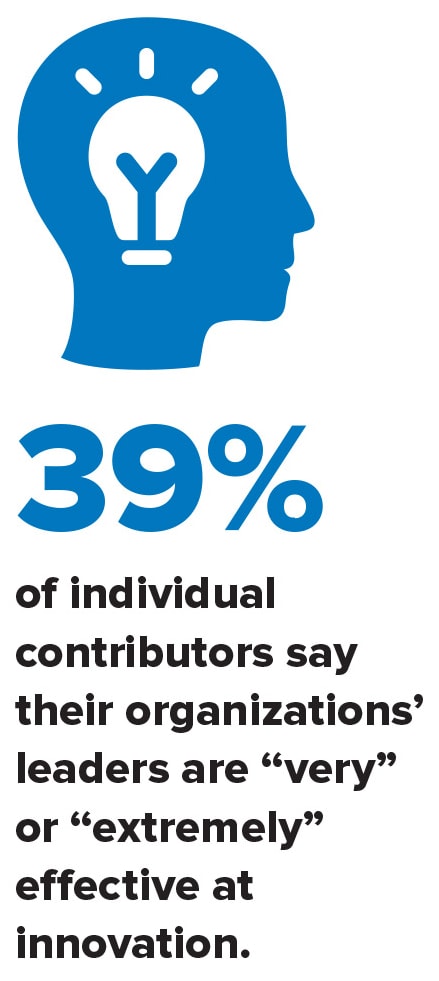Research + Insights: Changing the Face of Leadership
In this survey conducted for the Summer 2023 People + Strategy journal, the SHRM Research team looks at how U.S. employees and HR executives view the current (and future) state of leadership.
The Changing Face of Leadership
To gain insights into the evolving nature of leadership in the 21st century, SHRM Research surveyed 258 U.S. HR executives and 1,002 U.S. individual contributors in May 2023. This study aims to shed light on the evolving expectations and priorities of leaders as they navigate the dynamic and unpredictable landscape of the modern business world.

Understanding leaders' strengths and weaknesses in conjunction with the behaviors needed for organizational success empowers organizations to strategically target their development efforts. This approach ensures that development programs are aligned with the organization's current and future needs, leaving no gaps unaddressed.

The Critical Role of Innovation in Leadership
By Ragan Decker, Evan Pearson and Daroon Jalil
Between geopolitical tensions, trade disputes, rapid technological advancements, evolving regulations and the economic and social aftermath of the COVID-19 pandemic, the business landscape has grown increasingly volatile, uncertain, complex and ambiguous (VUCA) in recent years. Organizational leaders must not only successfully navigate these challenges, but also deliver results and maintain profitability.

This new reality begs the question: What behaviors are essential for leaders to succeed in today's dynamic business environment?
New SHRM research surveying HR executives and individual contributors identifies key leadership behaviors that have played a critical role in the success of organizational leaders in the past (2016) and the present (2023), and are expected to be essential in the future (2030).
SHRM research found that "strategizing" and "inspiring" remain essential behaviors across all three time frames, while traditional behaviors—such as task delegation and timely delivery of results—have diminished in importance. In their place, several dynamic behaviors, such as adapting quickly to changing circumstances, fostering innovation and being transparent about decisions have been pushed to the forefront and are expected to remain essential for organizational success in the future.
The importance of innovative leadership behaviors for organizational success has increased considerably over time. While about 34 percent of HR executives considered innovative behaviors to be among their top five most important leader behaviors in 2016, 40 percent placed innovation in their top five today. And more than half (54 percent) foresee innovation in their top five in 2030.
In fact, innovative behaviors are often viewed by HR executives (63 percent) and individual contributors (48 percent) as a characteristic of truly exceptional leadership. However, both groups acknowledge that innovation is a weak point among organizational leaders. HR executives themselves ranked innovating as one of the areas they're currently least likely to excel at, with 43 percent ranking it in the bottom five, making it leaders' third least effective behavior. What's more, only 39 percent of individual contributors believe their organizational leaders are very or extremely effective at innovation.
Driving Innovation: 3 Steps for Leaders
Innovating is a complex and challenging behavior that requires unique skills, mindset and organizational support. While this weakness is understandable, it cannot be ignored or excused if organizations want to remain competitive and successful in VUCA business conditions. We recommend leaders start by focusing on three areas to embrace and drive innovation, ultimately boosting growth and success in today's fast-paced and competitive business landscape:
1. Foster a culture of innovation
An innovative workplace culture can encourage and facilitate more innovative behaviors from all employees, including leaders. Leaders can cultivate a culture of innovation by promoting curiosity, openness and experimentation across the organization. However psychological safety is critical to the success of such efforts. To overcome this hurdle and establish an environment conducive to innovation, it is important to reward employees for their bold ideas, experimentation and willingness to challenge the status quo.
2. Collaborate with others
Collaboration is a foundational steppingstone to innovation. Collaboration harnesses the synergy of diverse expertise and perspectives, which allows leaders to generate innovative ideas, solve complex problems and drive forward with creative solutions. In fact, "collaborate" was ranked as one of areas that HR executives say they are currently excelling in, with 42 percent ranking it in the top five, making it executives' third most effective behavior.
Organizational leaders can leverage their collaboration skills to become more innovative. Fortunately, leaders may find little resistance when collaborating directly with employees, as more than 1 in 3 individual contributors (35 percent) ranked "collaborate" among the top five leader behaviors most important for organizational success, and 67 percent believe collaboration is an expected leadership behavior.
3. Stay connected with trends
Staying connected to trends is one approach to gaining unique and valuable insights that can shape strategic plans and investments to ensure that organizational growth is aligned with existing goals and values. However, leaders should strive to predict workplace trends, not just be aware of them.
Previous SHRM research shows that HR executives who excel at predicting workplace trends are more likely to also excel at driving change (61 percent versus 45 percent) compared to their counterparts who struggle with predicting trends (The Evolving Role of the CHRO, SHRM, 2022). Therefore, being aware of and forecasting trends can further enhance an organizational leader's effectiveness in bringing about meaningful changes and navigating the VUCA business landscape.
Ragan Decker, Ph.D., Evan Pearson and Daroon Jalil are researchers at SHRM.
An organization run by AI is not a futuristic concept. Such technology is already a part of many workplaces and will continue to shape the labor market and HR. Here's how employers and employees can successfully manage generative AI and other AI-powered systems.



